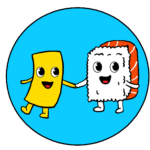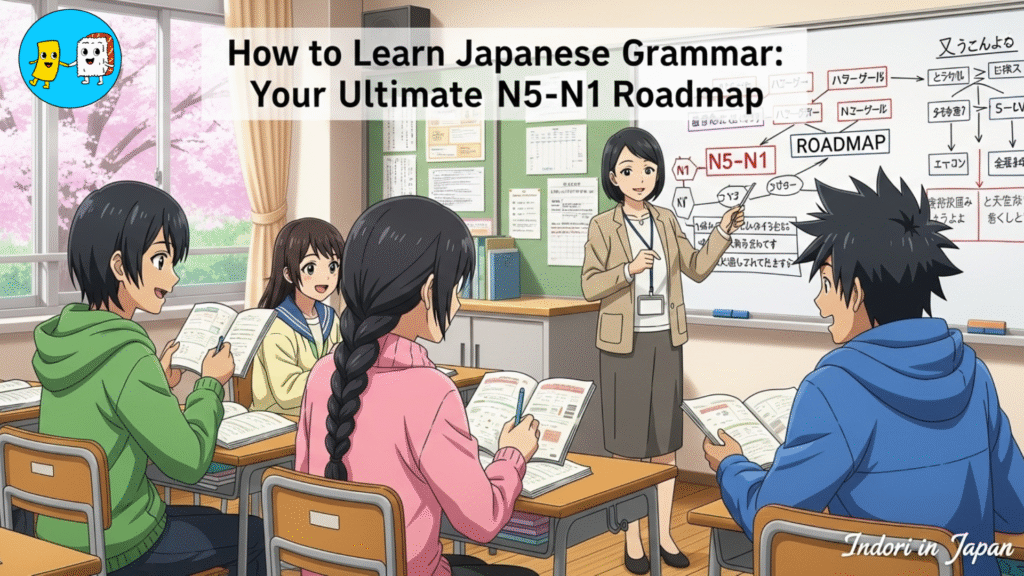How to Learn Japanese Grammar: Your Ultimate N5-N1 Roadmap (2025 Guide)
皆さん、こんにちは!(Hello everyone!)
"Akash Bhai, Grammar Kaise Seekhein?" – Your Senpai's Answer
Konnichiwa, my friends!
Akash here, your very own Indori in Japan. Every single day, my DMs are flooded with questions that all sound something like this: “Akash bhai, Japanese kaise seekhein?” “Is the grammar too hard for us Indians?” “Where do I even start?”. I see your ambition, I feel your excitement, and I completely understand your anxiety. I’ve been there.
When I first started my journey, the mountain of Japanese grammar looked impossibly high. Particles like (wa) and (ga), verb conjugations, polite forms… it felt overwhelming. But I’m here to tell you something very important: you can absolutely do this. Think of me as your senpai—someone who has walked this path before you and is here to share the map.
So, I decided to put everything I know, every resource I’ve used, and every strategy I’ve learned into one place. This isn’t just another blog post; it’s your complete roadmap and the ultimate guide to learning Japanese grammar, designed to take you from zero to hero. This guide covers the best free and paid resources for JLPT N5, N4, N3, N2, and N1 preparation.
First, let’s get one thing straight. Many of you, especially in the IT field, ask if you can get a job without knowing Japanese. Let me be blunt: choosing not to learn the language is a critical mistake. You might land a job, but you will inevitably hit a career ceiling. More importantly, you’ll miss out on truly living in this incredible country. Daily life, from visiting a doctor to dealing with city hall paperwork, becomes a constant struggle. To truly build a life and thrive here, Japanese is not optional; it is essential.
Grammar is the skeleton of the language. Vocabulary words are the bricks, but grammar is the blueprint that tells you how to build the house. Without it, you just have a pile of words. The good news? Japanese grammar is surprisingly logical. Verbs are consistent, and they don’t change based on who is doing the action. Nouns have no gender, and there are no plurals to memorise. The “difficulty” is heavily front-loaded. Once you clear the initial hurdles, it gets smoother.
In this guide, I’m going to give you the ultimate toolkit: a curated list of the 10 best free and paid resources that will take you all the way from JLPT N5 to N1. We’ll break down what to use, when to use it, and how to get the most out of it.
So, are you ready? Chalo, let’s get started!
Your N5-N1 Japanese Grammar Toolkit: A Quick-Look Guide
Before we dive deep into each resource, I want to give you a bird’s-eye view of the entire toolkit. I know you’re busy, so think of this table as your quick reference guide. It’s designed to help you see the whole path at a glance and understand the specific role each tool plays in your journey. The process of choosing from the hundreds of available resources can be overwhelming; this curated list is meant to remove that stress, giving you a clear, actionable plan so you can focus on what really matters: learning.
| Resource Name | Best For (JLPT Level) | Type | Cost | Akash's Key Takeaway |
|---|---|---|---|---|
| Mastering N5 Course | N5 | Video Course | Paid | The perfect flexible start for busy professionals. Learn at your own pace with my direct support. |
| Yoisho Courses | N5, N4, N3, N2, N1 | Live Classes | Paid | For those who need structure and a real classroom feel, online. |
| Genki I & II | N5, N4 | Textbook | Paid | The "university standard" foundation. A must-have physical book for serious learners. |
| Tae Kim's Guide to Learning Japanese | N5, N4 | Website/App | FREE | The best FREE online grammar guide, period. Your digital grammar sensei. |
| OMG Japan | N3, N2, N1 | Textbook Series | Paid | Your 6-week sprint planner to conquer any JLPT level. Great for structured prep. |
| Shin Kanzen Master books | N3, N2, N1 | Textbook Series | Paid | The "final boss" of JLPT prep. In-depth and challenging, for those aiming for a perfect score. |
| Bunpro Japanese | N5-N1 | App/Website | Paid (Freemium) | Your personal grammar gym. Drills grammar points into your brain with smart flashcards. |
| Imabi | N3-N1 | Website | Free | The "PhD level" free resource for understanding the deepest nuances of grammar. |
| The Japana Times - Digital STORE | N3-N1 | Book Series | Paid | The ultimate grammar bible. Your go-to reference to solve any grammar doubt. |
| Anki | N5-N1 | App | FREE | The most powerful memory tool. Your customizable flashcard engine for everything. |
The Foundation (N5-N4): Building Your Japanese 'Ghar'
Every great structure needs a solid foundation. In Japanese, the N5 and N4 levels are exactly that. If you rush this part or build on a weak base, you’ll face problems later when the grammar gets more complex. This is where you build your Japanese ghar (home), brick by brick. Get this right, and the rest of the journey becomes much, much easier. Here are the essential tools for this stage.
Resource 1: The Self-Starter's Path (My Course) - Indori in Japan
I created this course for one simple reason: I wanted to build the resource I wish I had when I first started. It’s designed specifically for busy Indian professionals and students who need the flexibility to learn on their own schedule without sacrificing quality or support.
- What You Get: This is a comprehensive, self-paced video course with over 40 hours of content that you get lifetime access to—including all future updates for free. We cover everything you need to build a rock-solid N5 foundation:
- Reading and Writing: Master all 92 Hiragana and Katakana characters until you can read and write them confidently.
- Vocabulary: Build a core vocabulary of over 500 essential words for everyday life.
- Grammar: Understand all the core N5 grammar patterns, from basic sentence structure and particles (は, が, を, に, で, の) to verb conjugations (desu/masu forms).
- Kanji: Learn the fundamental Kanji required for the N5 level.
- My Personal Touch (The Game-Changer): Here’s what makes this course different. While the lessons are pre-recorded for flexibility, you’re not learning alone. With the Complete JLPT N5 plan, you get access to monthly live group Q&A sessions with me. This is where you can ask me anything, clear your doubts, and get direct feedback. It’s the perfect blend of self-paced learning and personal mentorship.
- Who It’s For: If you have a demanding job or a hectic college schedule, this is your solution. You can learn anytime, anywhere, at your own pace, without the pressure of a fixed class schedule.
Ready to start your journey the right way? Enroll Now and let’s build your foundation together.
Resource 2: The Classroom Experience (Live & Interactive) - yoisho Academy
I understand that the self-study route isn’t for everyone. Some of us thrive on structure, deadlines, and the energy of a live classroom. If you’re someone who says, “Akash bhai, I need a proper class to stay disciplined,” then I have the perfect recommendation for you.
Yoisho.in offers a fantastic alternative with their live, interactive online classes. This isn’t a pre-recorded course; it’s a real, virtual classroom where you can engage directly with experienced instructors and fellow students. By recommending a trusted partner for live classes, I can ensure that even those who prefer a different learning style get the best start possible, reinforcing my role as a guide for everyone, not just a seller of my own product. This approach ensures that you find the right fit for your needs, which is my ultimate goal.
- What to Expect: Yoisho Academy provides an intensive and structured curriculum designed by experts. Their beginner courses for JLPT N5 and N4 are 12-week programs, with classes held 5 days a week. This amounts to a total of 90 hours of comprehensive, live instruction, building a solid foundation in reading, writing, listening, and speaking.
- Why It Works: The live format provides accountability and immediate feedback. You’re part of a supportive community, which is incredibly motivating. They even offer trial classes so you can experience their teaching method before committing.
- Who It’s For: This is ideal for learners who need a fixed schedule to stay on track, value real-time interaction with teachers, and enjoy learning in a group environment.
For those who want that classroom energy and discipline, I highly recommend checking out. Enroll Now
Resource 3: The Classic Textbook Route - Genki I & II
No matter what digital tools you use, having a physical textbook is invaluable. And when it comes to beginner textbooks, the Genki series is the undisputed gold standard, used in universities all over the world.
- How It’s Structured: Genki’s magic lies in its practical, context-based approach. Each chapter is built around a dialogue focusing on a real-life situation, like shopping or making plans with friends. The grammar points and vocabulary you learn are immediately tied to that situation, making them easier to understand and remember.
- Why It’s Essential: It’s a comprehensive, all-in-one resource. The two volumes cover reading, writing, grammar, vocabulary, and listening exercises.
Crucial Tip: Make sure you buy the accompanying workbook. The exercises in the workbook are absolutely necessary to practice and solidify what you learn in the main text. - Target Level: Completing both Genki I and Genki II will comfortably bring you to the JLPT N4 level, giving you a very strong and well-rounded foundation for the intermediate stages.
Resource 4: The Best Free Starting Point - guide to japanese
I’m a big believer that you don’t have to spend a fortune to learn Japanese. And to prove it, let me introduce you to Tae Kim’s Guide to Learning Japanese. This is, without a doubt, the most respected and comprehensive free grammar guide available on the internet.
- What It Is: Tae Kim’s guide is a no-nonsense, logical breakdown of Japanese grammar. It explains concepts from the very basics to advanced topics with clarity and excellent example sentences. Think of it as your digital grammar sensei.
- How to Use It: I don’t recommend using this as your only learning resource, because it lacks the interactive exercises of a full course. Instead, use it as your primary supplement. When a grammar point in Genki or my N5 course seems confusing, look it up in Tae Kim’s guide. His explanations will almost certainly clear things up.
- Accessibility: It’s available as a free website and also as a handy app for both Android and iOS, making it a perfect on-the-go reference tool.
The Climb (N3-N2): Conquering the Intermediate Plateau
Welcome to the great climb. The jump from N4 to N3, and especially from N3 to N2, is where many learners get stuck. This is famously known as the “intermediate plateau.” The amount of new vocabulary and grammar increases exponentially, and it can feel like you’re not making progress. But this is where you separate the serious learners from the hobbyists. This stage is a test of your consistency and your strategy. The tools I’ve selected for this section are designed not just to teach you the material, but to give you the psychological support and structure needed to break through this plateau and keep moving forward. Chalo, let’s climb this mountain together.
Resource 5 & 6: The JLPT Prep Powerhouses - OMG Japan V/S Shin Kanzen Master books
When you decide to get serious about passing the JLPT, two names stand above all others: Nihongo So-Matome and Shin Kanzen Master. These are not general textbooks; they are specialised training manuals designed to get you across the finish line. The one you choose depends entirely on your learning style.
Nihongo So Matome: Prepare for your JLPT exam in 6 weeks (The Sprinter)
- The Pitch: Think of this series as your personal JLPT sprint planner. Its defining feature is its brilliant structure: each book (Grammar, Vocab, Kanji, Reading, Listening) is designed to be completed in just 6 weeks. It takes the overwhelming mountain of N3 or N2 content and breaks it down into manageable, daily lessons. This structure provides a constant sense of accomplishment, which is crucial for staying motivated.
- Best For: This is the perfect choice for anyone studying while working a full-time job or dealing with a busy schedule. If you need a clear, time-bound plan that tells you exactly what to study each day, So-Matome is your best friend.
Shin Kanzen Master books: A comprehensive guide to the JLPT (The Marathoner)
- The Pitch: If So-Matome is a sprint, Shin Kanzen Master is a marathon. This series is widely considered the most in-depth, exhaustive, and challenging JLPT preparation material available. It doesn’t just teach you enough to pass; it prepares you to
master the content. It’s for those who aren’t just aiming to pass, but to get a high score and build a truly deep understanding. - The Key Challenge/Benefit: A major feature of this series is that from the N2 level onwards, all explanations are in Japanese. This can be a shock at first, but it’s a powerful way to force immersion and get you comfortable thinking in Japanese. It’s a challenge, but one that pays off immensely.
- Best For: This is for the dedicated learner who is ready to go all-in. If you want the most comprehensive preparation possible and are not afraid to be challenged, choose Shin Kanzen Master.
Resource 7: Your Digital Grammar Gym - Bunpro japanese
Here’s a common problem at the intermediate level: you read a grammar explanation in a textbook, you understand it, but a week later, you’ve forgotten how to use it. This is where bunpro.jp comes in. It’s the solution to the “forgetting curve.”
- The Pitch: I call Bunpro your personal grammar gym. It’s a website and app built around a Spaced Repetition System (SRS) designed specifically for grammar.
- How It Works: Bunpro takes every grammar point from N5 to N1 and turns it into an interactive quiz. It presents you with a Japanese sentence with a blank space and asks you to fill in the correct grammar. This forces active recall, which is far more effective for memory than passive reading. The SRS algorithm then tracks which points you know well and which you struggle with, and it schedules reviews at the perfect time to burn the information into your long-term memory.
- Why It’s a Game-Changer: Bunpro automates the most tedious part of learning: review. It bridges the gap between knowing a grammar rule and being able to use it instinctively. It’s the digital personal trainer that will get your grammar muscles in shape.
Resource 8: The Deep Dive (Free) - Imabi
If Tae Kim’s Guide was your Bachelor’s degree in Japanese grammar, consider Imabi your PhD. This free website is an absolute treasure trove of information for the serious learner.
- The Pitch: Imabi is where you go when you need the deepest, most detailed explanation of a grammar point that you can find anywhere online, for free. It often delves into the history, etymology, and subtle nuances of grammar that most other resources (even paid ones) don’t cover.
- How to Use It: This is not a resource you read from start to finish. It’s a reference tool. When you’re working through Shin Kanzen Master and you encounter a grammar point that still feels fuzzy, or you want to understand the subtle difference between two similar expressions, you look it up on Imabi. Its exhaustive explanations will provide the clarity you need. It’s the ultimate safety net, ensuring no grammar point remains a mystery.
The Summit (N1): Mastering the Art of Nuance
Reaching the N1 level is like standing at the summit of a great mountain. The air is thin, and the view is incredible. At this stage, you’ve learned most of the common grammar patterns. The challenge of N1 is not about learning hundreds of new rules, but about mastering nuance, precision, reading speed, and the subtle shades of meaning that separate a proficient speaker from a near-native one. You know the rules; now it’s time to learn the art.
Resource 9: The Grammar Bible - A Dictionary of Japanese Grammar Series
If there is one resource that every serious student of Japanese should own, it is this three-volume series: A Dictionary of Japanese Grammar Series. These books are, quite simply, the most authoritative and comprehensive reference on Japanese grammar ever published in English.
- The Pitch: This is your grammar bible. It’s not a textbook you read cover-to-cover; it’s an encyclopedic reference you will consult for the rest of your Japanese-learning life.
- Why It’s Essential for N1: The JLPT N1 exam loves to test you on the subtle differences between very similar-looking grammar points. For example, what’s the real difference in nuance between (ni saishite) and (ni atatte)? Your textbook might give you a short explanation, but this dictionary series will give you pages of analysis, multiple example sentences, and clear explanations of common mistakes. This is the level of detail you need to conquer N1.
- How to Use It: Start by buying the “Basic” volume, even if you’re already at an advanced level. It covers N5-N3 grammar in such incredible depth that it will reveal nuances you never knew existed. As you advance, add the Intermediate (N3-N2) and Advanced (N2-N1) volumes to your collection. Whenever you encounter a grammar point you’re unsure of, you look it up. It is the ultimate court of appeal for any grammar question.
Resource 10: The Ultimate Memory Tool - Anki
We met Anki in the N5-N4 section, but at the N1 level, it transforms from a simple study tool into the engine of your entire learning process. It is the most powerful, customizable, and effective memory tool available, and it remains completely free.
- The Pitch: Anki is based on active recall and spaced repetition, the two most scientifically-backed principles for long-term memory formation. At the advanced level, you stop using pre-made decks and start creating your own.
- The N1 Pro-Level Technique: Sentence Mining: This is the key. As an N1 student, you should be consuming a lot of native material—reading news articles on NHK News Web Easy, novels by authors like Haruki Murakami, or watching Japanese dramas. When you encounter a sentence that contains a new word, a tricky grammar point, or a subtle nuance you want to master, you “mine” that sentence and create a flashcard in Anki.
- Front of the card: The full Japanese sentence with the target word/grammar point highlighted or blanked out.
- Back of the card: The definition of the word, a brief explanation of the grammar, and maybe a link to your dictionary reference.
- Why It’s Crucial for N1: Sentence mining with Anki does two things. First, it ensures you never forget what you learn. Second, and more importantly, it teaches you grammar and vocabulary in context. You’re not just memorising a rule; you’re memorising how that rule is used in the real world by native speakers. This is the final step to internalising the language and making it your own.
Frequently Asked Questions (FAQ) for Japanese Learners
I get these questions all the time, so let’s clear them up for you!
- What is the best way to start learning Japanese grammar?
The best way is to start with a structured, foundational course. I recommend beginning with my Learn Japanese JLPT N5 course for self-paced learning or yoishoacademy.in live classes for more discipline. Combine this with a solid textbook like Genki and master Hiragana and Katakana first. This will build the strong base you need for everything that comes after. - Are free resources enough to learn Japanese grammar?
While free resources like Tae Kim’s Guide and Imabi are incredibly high-quality and essential for supplementing your studies, relying on them alone can be confusing for a beginner. A structured curriculum (usually from a paid course or textbook) provides a clear roadmap, which is crucial for building your knowledge logically. Use free resources as your reference library and practice tools. - How long does it take to reach JLPT N1?
This is a marathon, not a sprint. The time it takes varies greatly depending on your study intensity, methods, and background. For most people, reaching N1 from zero is a multi-year commitment that requires consistent, almost daily, study. Don’t focus on the timeline; focus on building a sustainable study habit. - Should I learn Kanji from the beginning?
Yes, 100%. Don’t put it off! Start with the basic 100-150 Kanji required for N5. Learning Kanji alongside vocabulary and grammar from day one is far more effective than trying to cram them all later. It makes reading easier, much faster and is a core part of the language.
Conclusion: Your Roadmap is Ready. Start Your Engine.
So there you have it—the complete roadmap and toolkit for mastering Japanese grammar, from your very first step at N5 to the summit of N1.
As you can see, there is no single “magic bullet” resource that will do everything for you. The real key to success is building a personalised study system that works for you. The most effective learners combine different types of resources to create a powerful toolkit:
- A Core Curriculum: A structured course or textbook to guide your learning (like my N5 Course, yoisho.in, or Genki).
- A Digital Practice Tool: An app that forces active recall and automates your reviews (like bunpro.jp).
- A Deep-Dive Reference: An authoritative source to look up confusing points (like guide to Japanese org, Imabi, or A Dictionary of Japanese Grammar).
- A Memory Engine: A customizable SRS to burn everything into your long-term memory (like Anki).
Let’s be real: learning Japanese is not a walk in the park. It takes time, consistency, and effort. There will be days when you feel stuck, and days when you want to give up. But I promise you, it is one of the most rewarding things you will ever do. Learning the language is the key that unlocks everything this amazing country has to offer—from its 2,000 years of rich history to ordering your ramen like a local.1 It’s what allows you to build a real career, form deep friendships, and truly feel at home here.
Your roadmap is ready. The path is clear. Now, it’s time for you to start your engine.
I’m here to help you on your journey. Here are the best next steps you can take right now:
- If you’re a beginner, the best first step you can take is to get a solid, flexible foundation. Master the Japanese JLPT N5 beginner course, and let’s start this journey together.
- If you need that classroom discipline, don’t wait. yoisho.in and find a batch that works for you
- For daily tips, motivation, and support, join our amazing community of learners who are all on the same path. Join my free WhatsApp community and connect with us!.
Ganbatte! I’ll see you in Japan.
✍️ Bonus: Need Help Starting?
✅ Job hunting tips and real listings for foreigners in Japan
✅ Visa guidance made simple—no confusing search
✅ Resume & cover letter templates (Japanese & English formats)
✅ Life in Japan explained — from rent to ramen
✅ Travel guides & city recommendations for every kind of explorer
✅ Work culture insights to help you adjust and thrive





